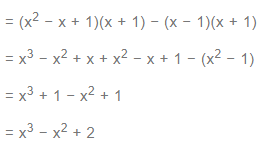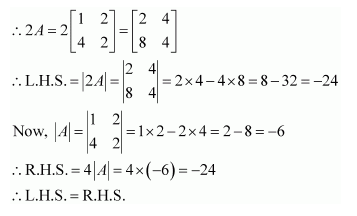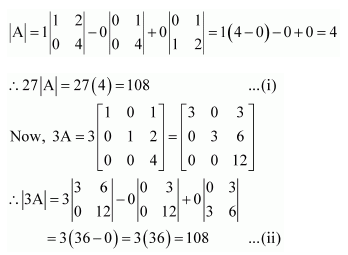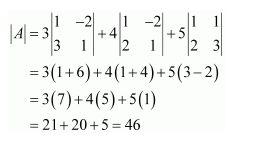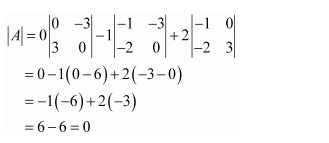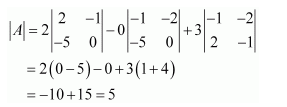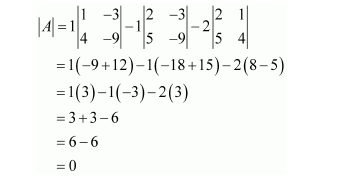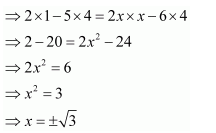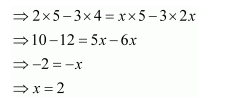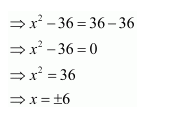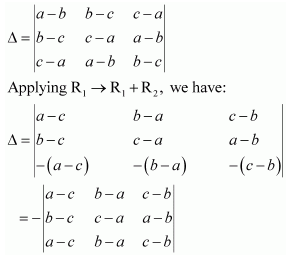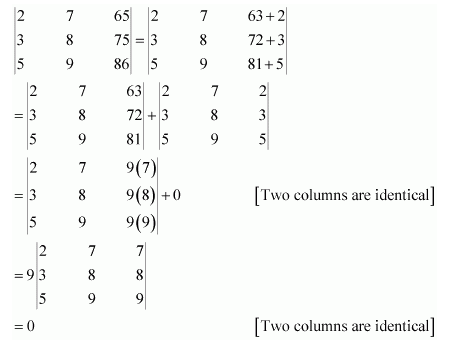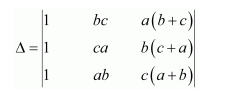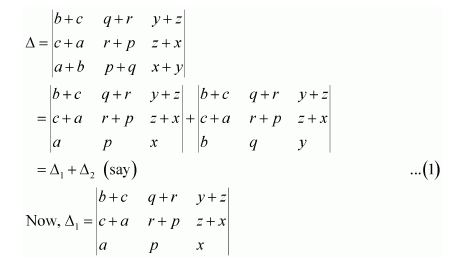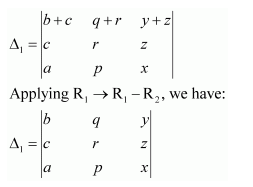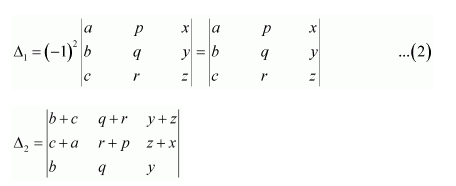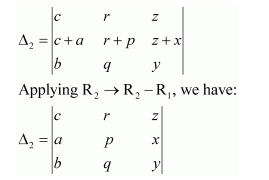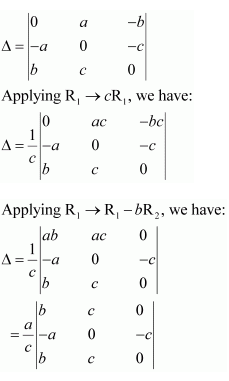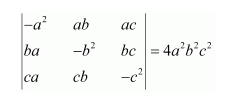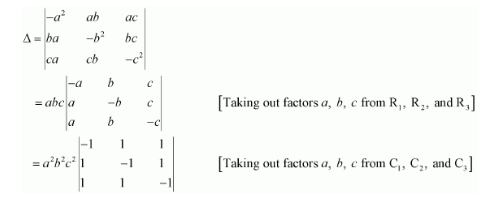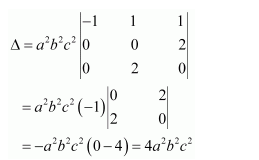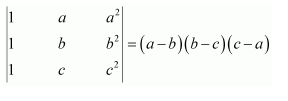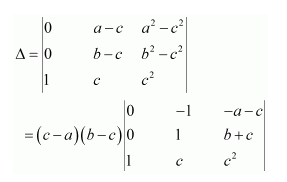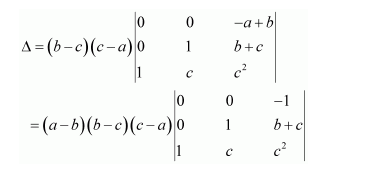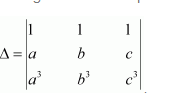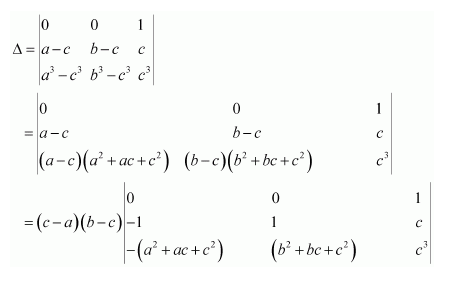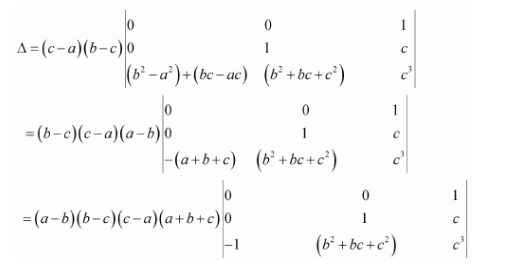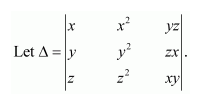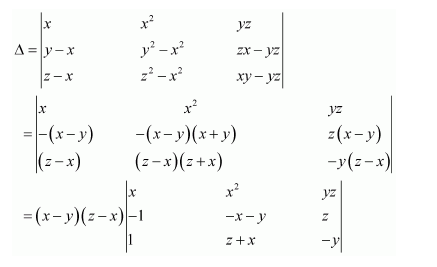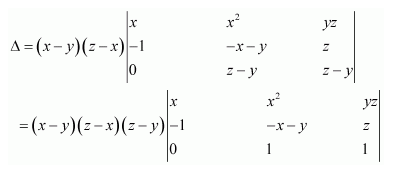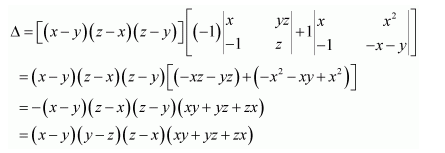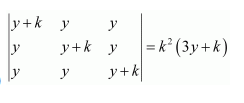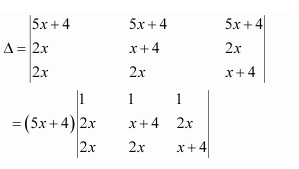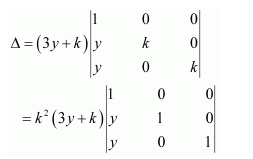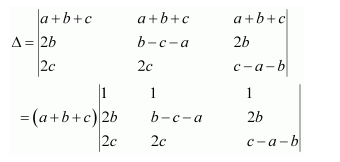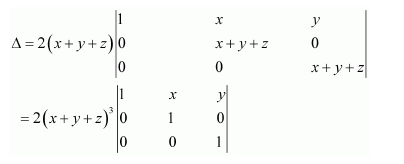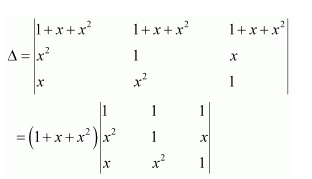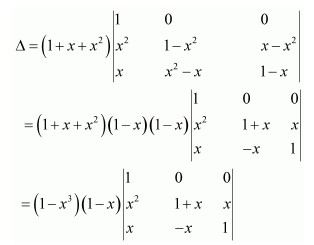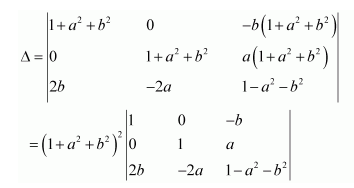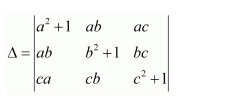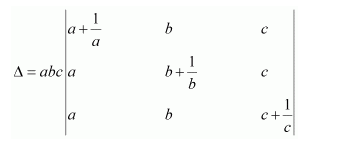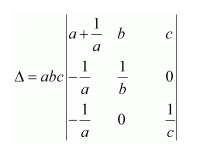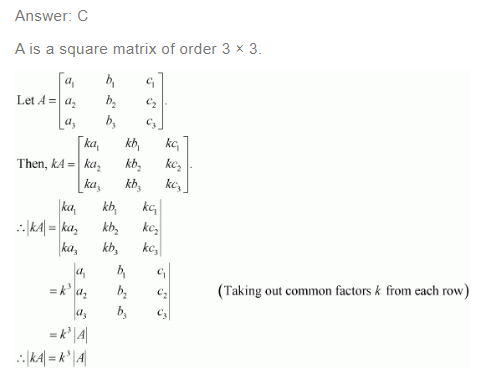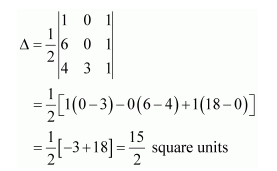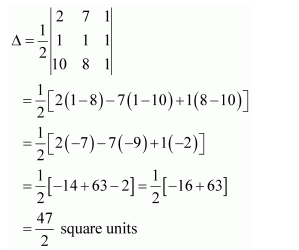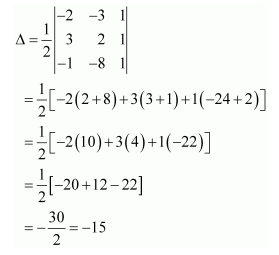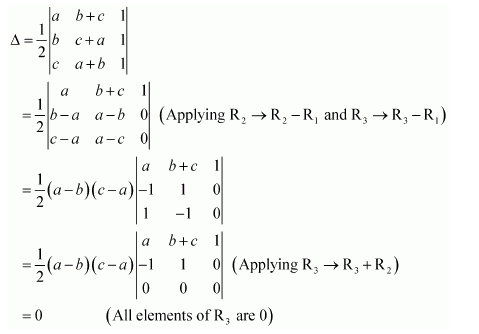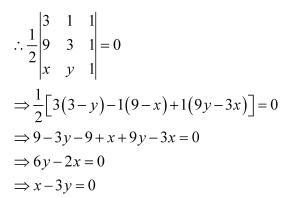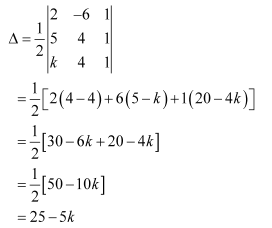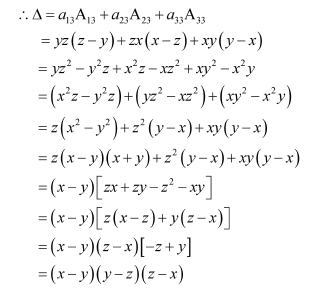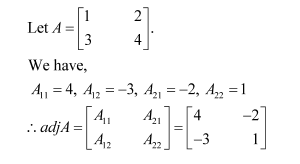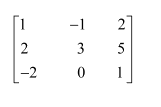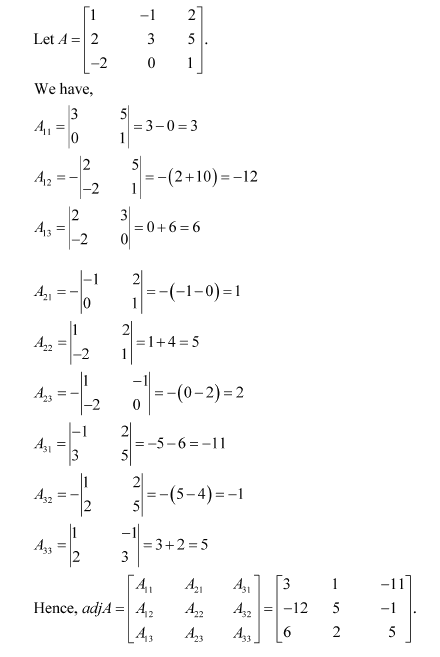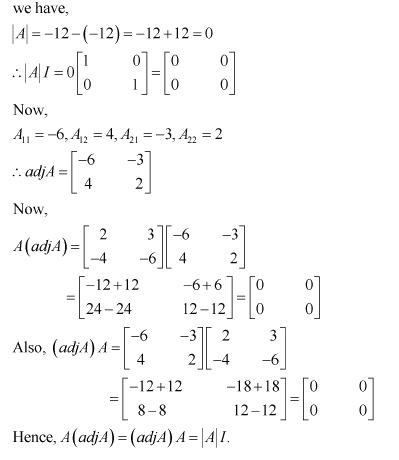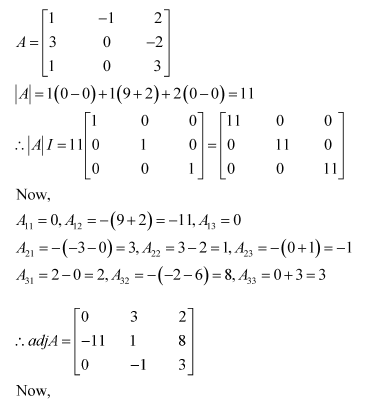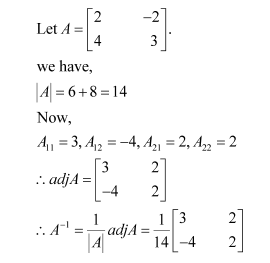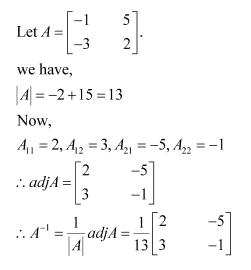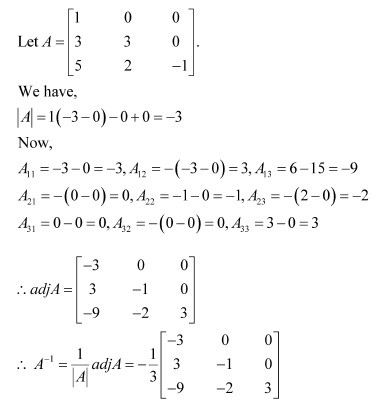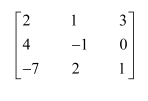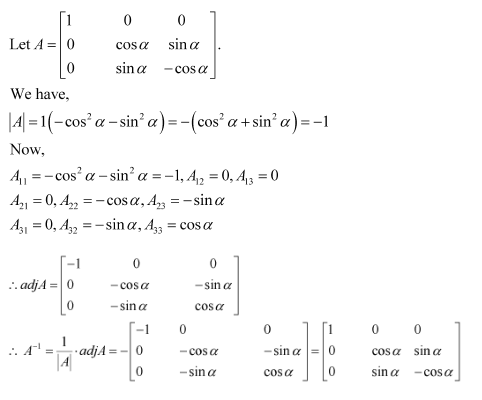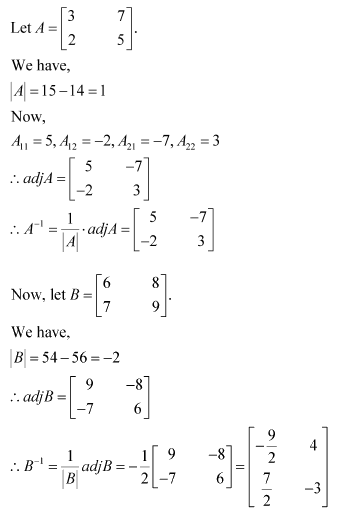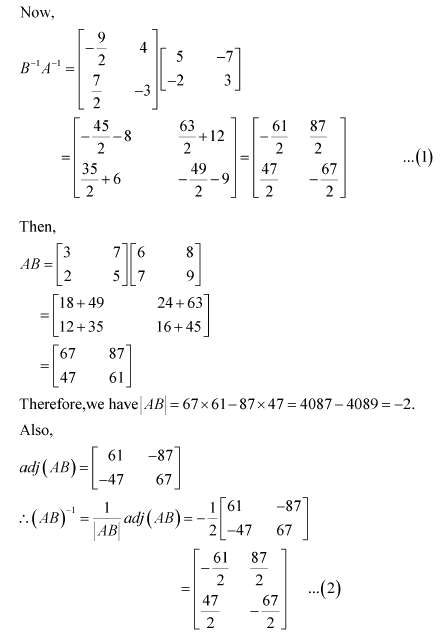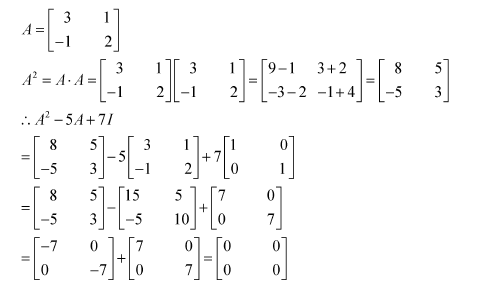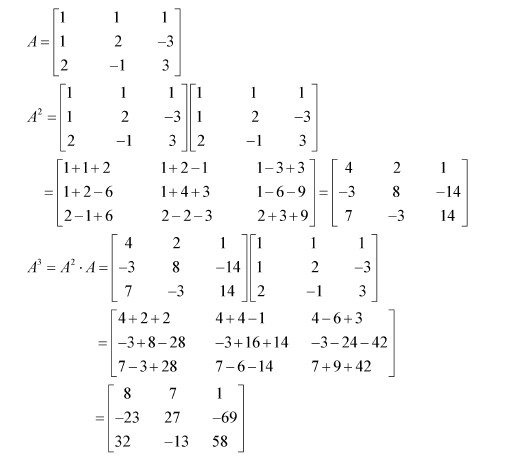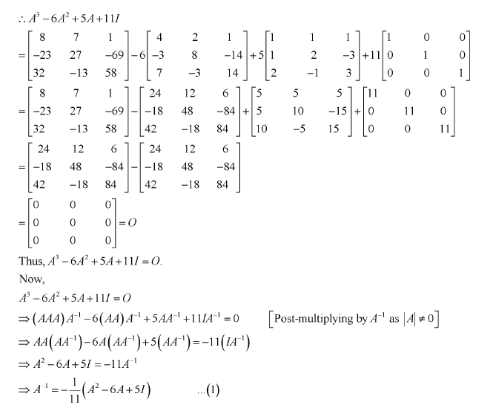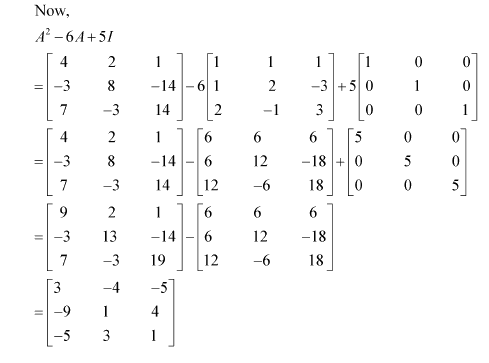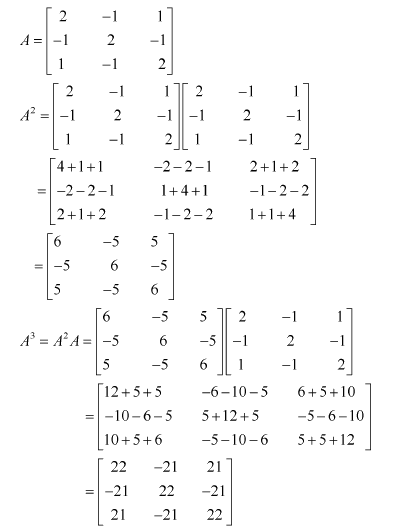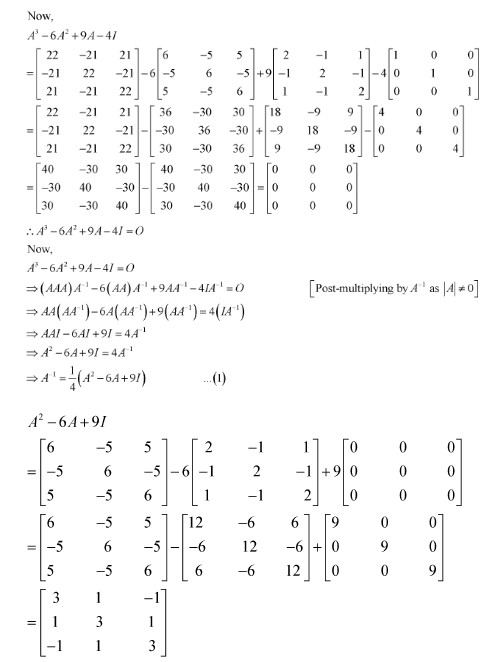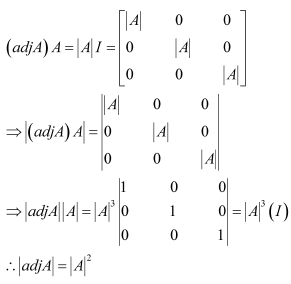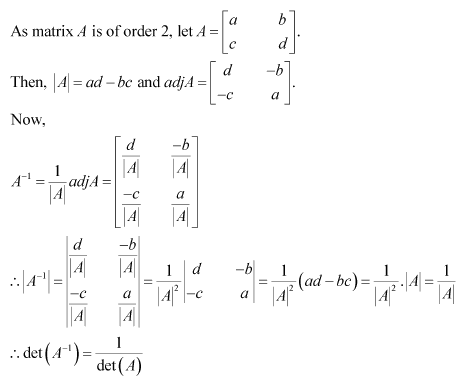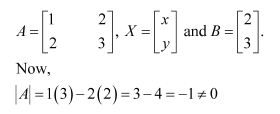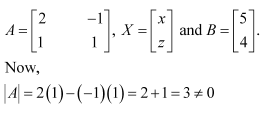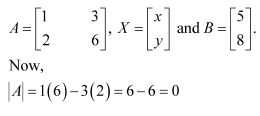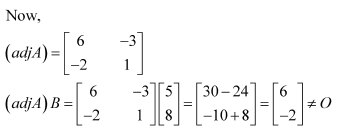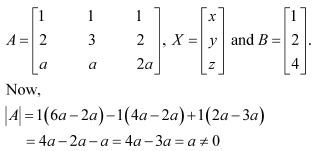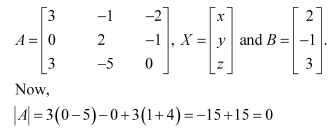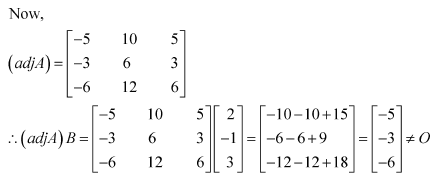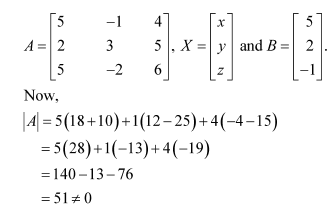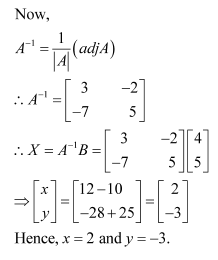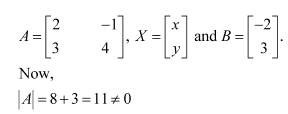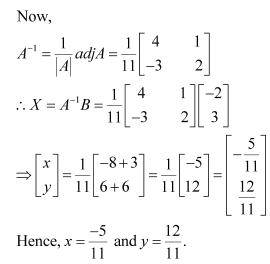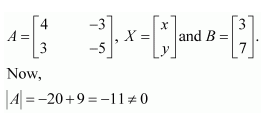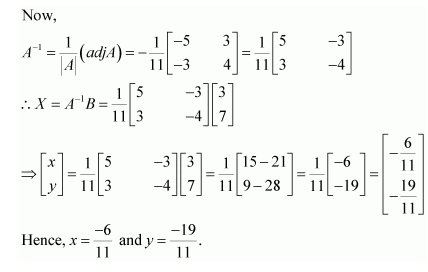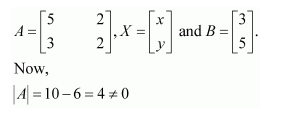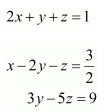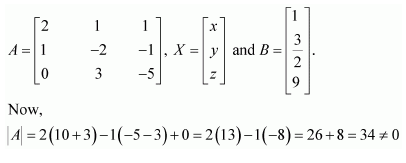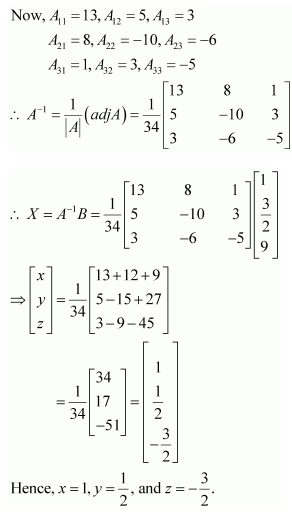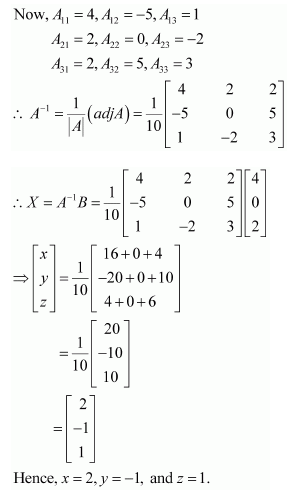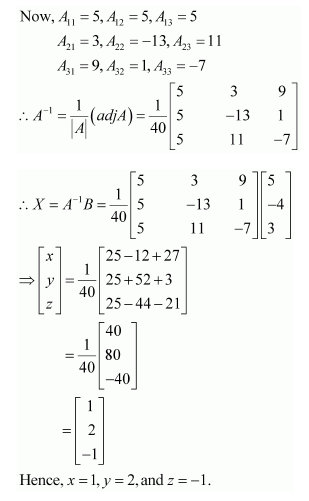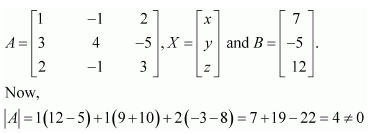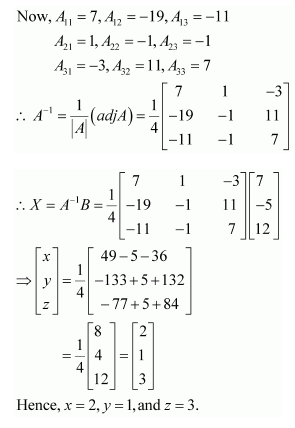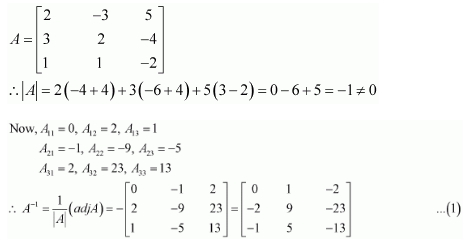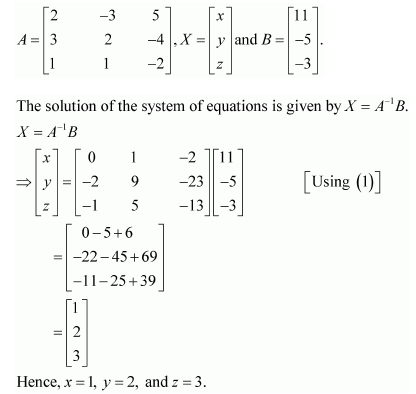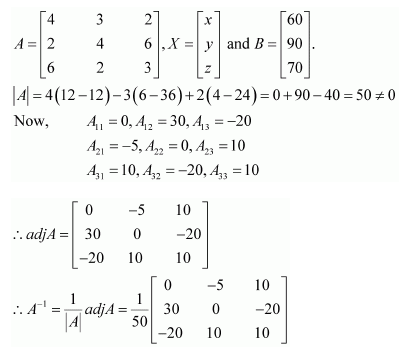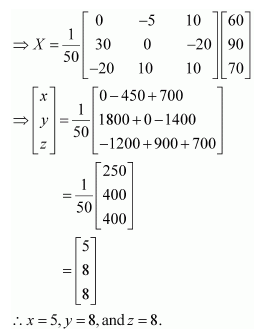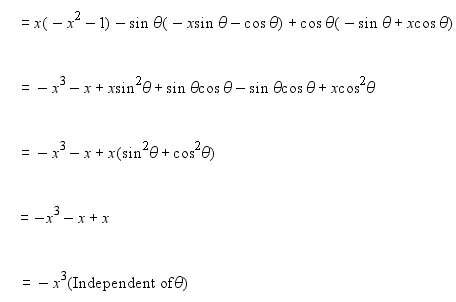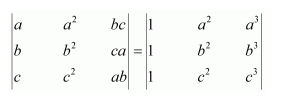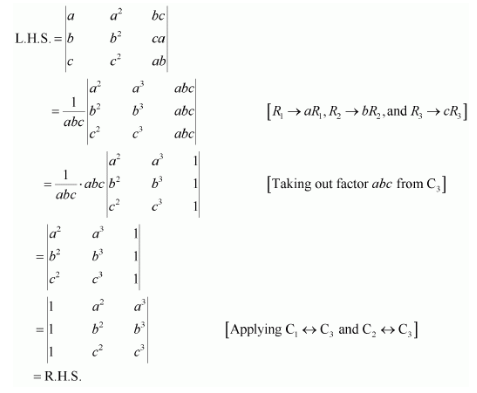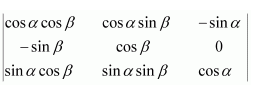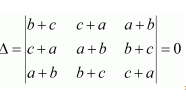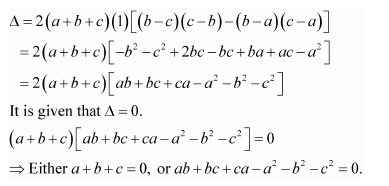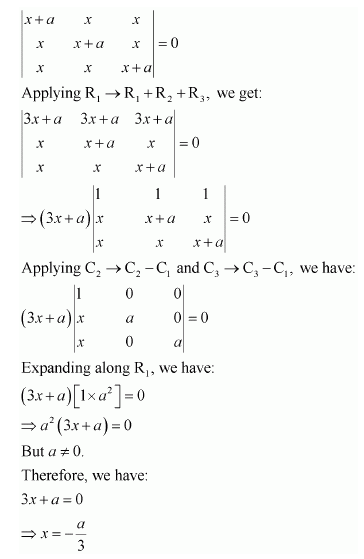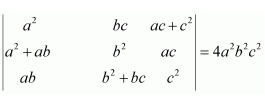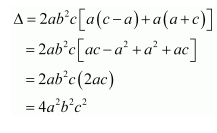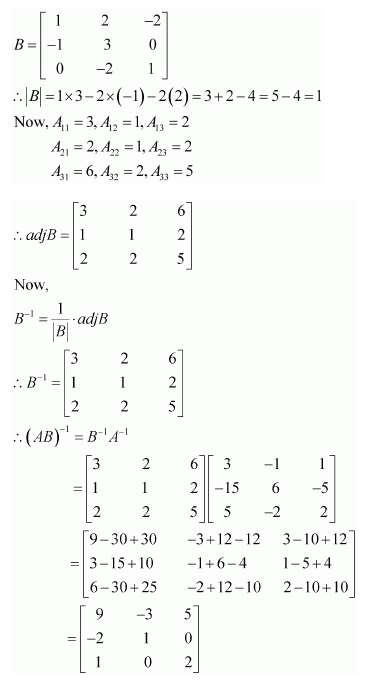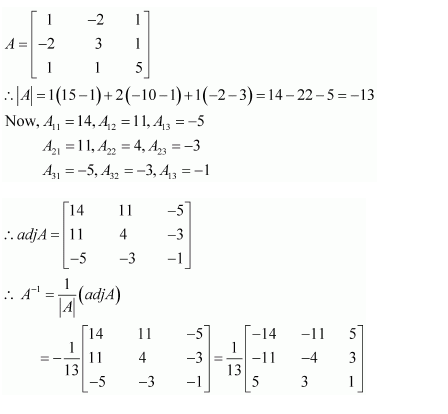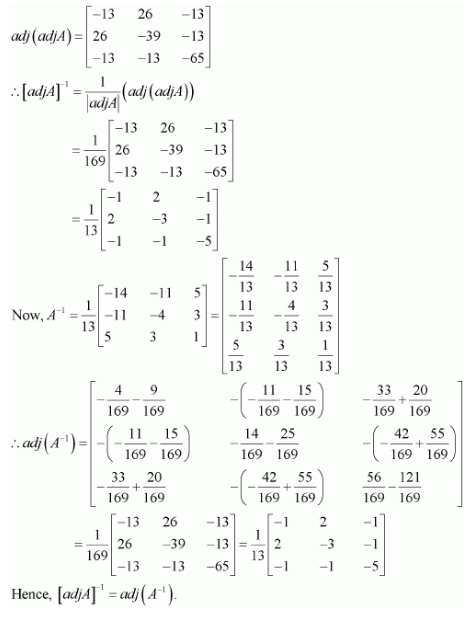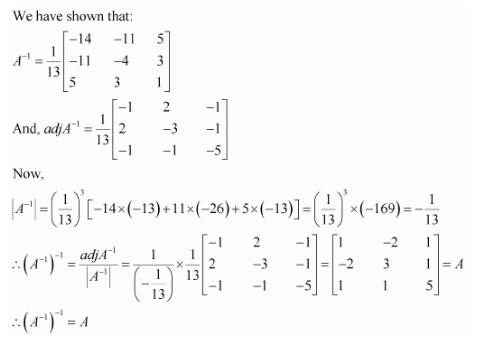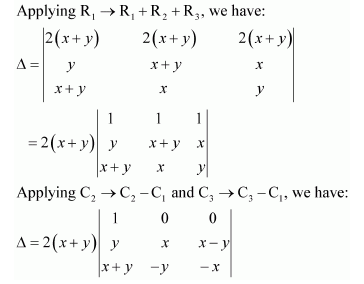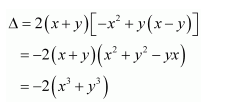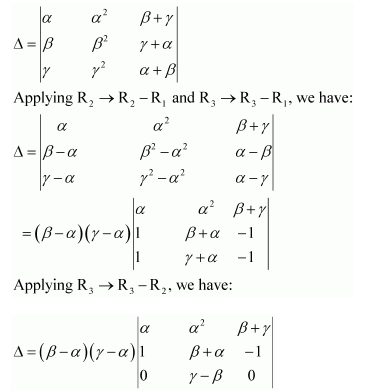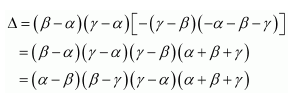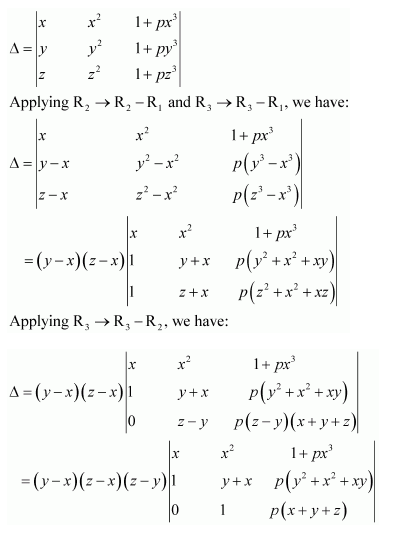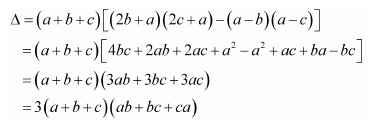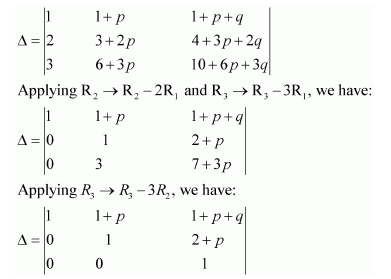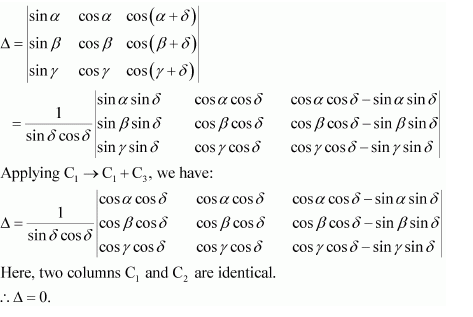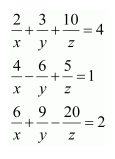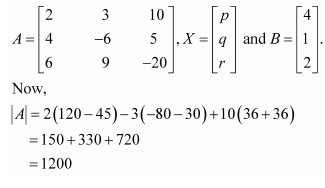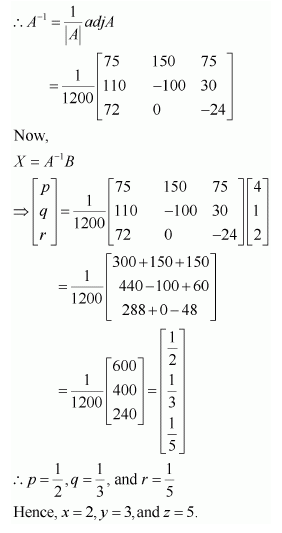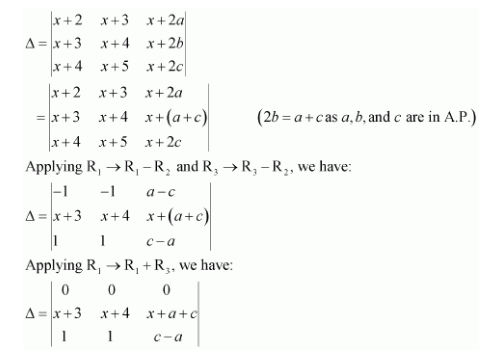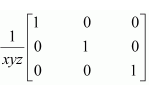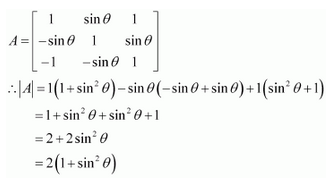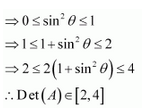NCERT Solutions For Class 12 Maths Chapter 4 will clear all the doubts which were related to the 4th chapter. Class 12 Maths NCERT Solutions will help in improving your problem-solving abilities. Students must practice the Class 12 Maths NCERT Book Solutions. We give topic-wise solutions for every question in Class 12 Maths NCERT Solutions and the Problems are solved by India’s best teachers. Students can prepare for CBSE Class 12 Maths NCERT Solutions Chapter 4 through this article for getting a better score in the CBSE exams. If the students practice the solutions multiple times, then it will be easier for them to solve the toughest problems that are appeared in the examinations. NCERT Solutions For Class 12 gives you the best results in CBSE board exams. You can clarify all doubts regarding this chapter 4 by simply downloading it.
Class 12 Maths NCERT Solutions Chapter 4 – Determinants
| Name Of The Section | Topic Name |
| 4 | Determinants |
| 4.1 | Introduction |
| 4.2 | Determinant |
| 4.3 | Properties of Determinants |
| 4.4 | Area of Triangle |
| 4.5 | Adjoint and Inverse of a Matrix |
| 4.6 | Summary |
NCERT Solutions For Class 12 Maths Chapter 4 Determinants Ex 4.1 – Introduction
Question 1:
Evaluate the determinants in Exercises 1 and 2.
Answer:

Question 2:
Evaluate the determinants in Exercises 1 and 2.
(i) 
Answer:
(i) 
(ii)
Question 3:
If 
Answer:
The given matrix is
Question 4:
If 
Answer:
The given matrix is
It can be observed that in the first column, two entries are zero. Thus, we expand along the first column (C1) for easier calculation.
From equations (i) and (ii), we have:
Hence, the given result is proved.
Question 5:
Evaluate the determinants
(i) 


Answer:
(i) Let A=
It can be observed that in the second row, two entries are zero. Thus, we expand along the second row for easier calculation.
(ii) Let A=
By expanding along the first row, we have:
(iii) Let A=
By expanding along the first row, we have:
(iv) Let A=
By expanding along the first column, we have:
Question 6:
If 
Answer:
Let
By expanding along the first row, we have:
Question 7:
Find values of x, if
(i) 
Answer:
(i)
(ii)
Question 8:
If
then x is equal to
(A) 6 (B) ±6 (C) −6 (D) 0
Answer:
Answer: B
Hence, the correct answer is B.
NCERT Solutions Class 12 Maths Chapter 4 Determinants Ex 4.2
Question 1:
Using the property of determinants and without expanding, prove that:
Answer:
Question 2:
Using the property of determinants and without expanding, prove that:
Answer:
Here, the two rows R1 and R3 are identical.
Δ = 0.
Question 3:
Using the property of determinants and without expanding, prove that:
Answer:
Question 4:
Using the property of determinants and without expanding, prove that:
Answer:
By applying C3 → C3 + C2, we have:
Here, two columns C1 and C3 are proportional.
Δ = 0.
Question 5:
Using the property of determinants and without expanding, prove that
Answer:
Applying R2 → R2 − R3, we have:
Applying R1 ↔R3 and R2 ↔R3, we have:
Applying R1 → R1 − R3, we have:
Applying R1 ↔R2 and R2 ↔R3, we have:
From (1), (2), and (3), we have:
Hence, the given result is proved.
Question 6:
By using properties of determinants, show that:
Answer:
We have,
Here, the two rows R1 and R3 are identical.
∴Δ = 0.
Question 7:
By using properties of determinants, show that:
Answer:
Applying R2 → R2 + R1 and R3 → R3 + R1, we have:
Question 8:
By using properties of determinants, show that:
(i)
(ii)
Answer:
(i)
Applying R1 → R1 − R3 and R2 → R2 − R3, we have:
Applying R1 → R1 + R2, we have:
Expanding along C1, we have:
Hence, the given result is proved.
(ii) Let
Applying C1 → C1 − C3 and C2 → C2 − C3, we have:
Applying C1 → C1 + C2, we have:
Expanding along C1, we have:
Hence, the given result is proved.
Question 9:
By using properties of determinants, show that:
Answer:
Applying R2 → R2 − R1 and R3 → R3 − R1, we have:
Applying R3 → R3 + R2, we have:
Expanding along R3, we have:
Hence, the given result is proved.
Question 10:
By using properties of determinants, show that:
(i)
(ii)
Answer:
(i)
Applying R1 → R1 + R2 + R3, we have:
Applying C2 → C2 − C1, C3 → C3 − C1, we have:
Expanding along C3, we have:
Hence, the given result is proved.
(ii)
Applying R1 → R1 + R2 + R3, we have:
Applying C2 → C2 − C1 and C3 → C3 − C1, we have:
Expanding along C3, we have:
Hence, the given result is proved.
Question 11:
By using properties of determinants, show that:
(i)
(ii)
Answer:
(i)
Applying R1 → R1 + R2 + R3, we have:
Applying C2 → C2 − C1, C3 → C3 − C1, we have:
Expanding along C3, we have:
Hence, the given result is proved.
(ii)
Applying C1 → C1 + C2 + C3, we have:
Applying R2 → R2 − R1 and R3 → R3 − R1, we have:
Expanding along R3, we have:
Hence, the given result is proved.
Question 12:
By using properties of determinants, show that:
Answer:
Applying R1 → R1 + R2 + R3, we have:
Applying C2 → C2 − C1 and C3 → C3 − C1, we have:
Expanding along R1, we have:
Hence, the given result is proved.
Question 13:
By using properties of determinants, show that:
Answer:
Applying R1 → R1 + bR3 and R2 → R2 − aR3, we have:
Expanding along R1, we have:
Question 14:
By using properties of determinants, show that:
Answer:
Taking out common factors a, b, and c from R1, R2, and R3 respectively, we have:
Applying R2 → R2 − R1 and R3 → R3 − R1, we have:
Applying C1 → aC1, C2 → bC2, and C3 → cC3, we have:
Expanding along R3, we have:
Hence, the given result is proved.
Question 15:
Choose the correct answer.
Let A be a square matrix of order 3 × 3, then is equal to
(A) (B)
(C)
(D)
Answer:
Answer: C
A is a square matrix of order 3 × 3.
Hence, the correct answer is C.
Question 16:
Which of the following is correct?
A. Determinant is a square matrix.
B. Determinant is a number associated to a matrix.
C. Determinant is a number associated to a square matrix.
D. None of these
Answer:
Answer: C
We know that to every square matrix, of order n. We can associate a number called the determinant of square matrix A, where
element of A.
Thus, the determinant is a number associated to a square matrix.
Hence, the correct answer is C.
NCERT Solutions For Class 12 Maths Chapter 4 Determinants Ex 4.3 Properties of Determinants
Question 1:
Find area of the triangle with vertices at the point given in each of the following:
(i) (1, 0), (6, 0), (4, 3) (ii) (2, 7), (1, 1), (10, 8)
(iii) (−2, −3), (3, 2), (−1, −8)
Answer:
(i) The area of the triangle with vertices (1, 0), (6, 0), (4, 3) is given by the relation,
(ii) The area of the triangle with vertices (2, 7), (1, 1), (10, 8) is given by the relation,
(iii) The area of the triangle with vertices (−2, −3), (3, 2), (−1, −8)
is given by the relation,
Hence, the area of the triangle is
Question 2:
Show that points are collinear
Answer:
Area of ΔABC is given by the relation,
Thus, the area of the triangle formed by points A, B, and C is zero.
Hence, the points A, B, and C are collinear.
Question 3:
Find values of k if area of triangle is 4 square units and vertices are
(i) (k, 0), (4, 0), (0, 2) (ii) (−2, 0), (0, 4), (0, k)
Answer:
We know that the area of a triangle whose vertices are (x1, y1), (x2, y2), and
(x3, y3) is the absolute value of the determinant (Δ), where
It is given that the area of triangle is 4 square units.
∴Δ = ± 4.
(i) The area of the triangle with vertices (k, 0), (4, 0), (0, 2) is given by the relation,
Δ =
∴−k + 4 = ± 4
When −k + 4 = − 4, k = 8.
When −k + 4 = 4, k = 0.
Hence, k = 0, 8.
(ii) The area of the triangle with vertices (−2, 0), (0, 4), (0, k) is given by the relation,
Δ =
∴k − 4 = ± 4
When k − 4 = − 4, k = 0.
When k − 4 = 4, k = 8.
Hence, k = 0, 8.
Question 4:
(i) Find equation of line joining (1, 2) and (3, 6) using determinants
(ii) Find equation of line joining (3, 1) and (9, 3) using determinants
Answer:
(i) Let P (x, y) be any point on the line joining points A (1, 2) and B (3, 6). Then, the points A, B, and P are collinear. Therefore, the area of triangle ABP will be zero.
Hence, the equation of the line joining the given points is y = 2x.
(ii) Let P (x, y) be any point on the line joining points A (3, 1) and
B (9, 3). Then, the points A, B, and P are collinear. Therefore, the area of triangle ABP will be zero.
Hence, the equation of the line joining the given points is x − 3y = 0.
Question 5:
If area of triangle is 35 square units with vertices (2, −6), (5, 4), and (k, 4). Then k is
A. 12 B. −2 C. −12, −2 D. 12, −2
Answer:
Answer: D
The area of the triangle with vertices (2, −6), (5, 4), and (k, 4) is given by the relation,
It is given that the area of the triangle is ±35.
Therefore, we have:
When 5 − k = −7, k = 5 + 7 = 12.
When 5 − k = 7, k = 5 − 7 = −2.
Hence, k = 12, −2.
The correct answer is D.
NCERT Solutions For Class 12 Maths Chapter 4 Determinants Ex 4.4 Area Of Triangle
Question 1:
Write Minors and Cofactors of the elements of the following determinants:
(i) 
Answer:
(i) The given determinant is
Minor of element aij is Mij.
∴M11 = minor of element a11 = 3
M12 = minor of element a12 = 0
M21 = minor of element a21 = −4
M22 = minor of element a22 = 2
Cofactor of aij is Aij = (−1)i + j Mij.
∴A11 = (−1)1+1 M11 = (−1)2 (3) = 3
A12 = (−1)1+2 M12 = (−1)3 (0) = 0
A21 = (−1)2+1 M21 = (−1)3 (−4) = 4
A22 = (−1)2+2 M22 = (−1)4 (2) = 2
(ii) The given determinant is
Minor of element aij is Mij.
∴M11 = minor of element a11 = d
M12 = minor of element a12 = b
M21 = minor of element a21 = c
M22 = minor of element a22 = a
Cofactor of aij is Aij = (−1)i + j Mij.
∴A11 = (−1)1+1 M11 = (−1)2 (d) = d
A12 = (−1)1+2 M12 = (−1)3 (b) = −b
A21 = (−1)2+1 M21 = (−1)3 (c) = −c
A22 = (−1)2+2 M22 = (−1)4 (a) = a
Question 2:
(i) 
Answer:
(i) The given determinant is
By the definition of minors and cofactors, we have:
M11 = minor of a11=
M12 = minor of a12=
M13 = minor of a13 =
M21 = minor of a21 =
M22 = minor of a22 =
M23 = minor of a23 =
M31 = minor of a31=
M32 = minor of a32 =
M32 = minor of a32 =
A11 = cofactor of a11= (−1)1+1 M11 = 1
A12 = cofactor of a12 = (−1)1+2 M12 = 0
A13 = cofactor of a13 = (−1)1+3 M13 = 0
A21 = cofactor of a21 = (−1)2+1 M21 = 0
A22 = cofactor of a22 = (−1)2+2 M22 = 1
A23 = cofactor of a23 = (−1)2+3 M23 = 0
A31 = cofactor of a31 = (−1)3+1 M31 = 0
A32 = cofactor of a32 = (−1)3+2 M32 = 0
A33 = cofactor of a33 = (−1)3+3 M33 = 1
(ii) The given determinant is
By definition of minors and cofactors, we have:
M11 = minor of a11=
M12 = minor of a12=
M13 = minor of a13 =
M21 = minor of a21 =
M22 = minor of a22 =
M23 = minor of a23 =
M31 = minor of a31=
M32 = minor of a32 =
M33 = minor of a33 =
A11 = cofactor of a11= (−1)1+1 M11 = 11
A12 = cofactor of a12 = (−1)1+2 M12 = −6
A13 = cofactor of a13 = (−1)1+3 M13 = 3
A21 = cofactor of a21 = (−1)2+1 M21 = 4
A22 = cofactor of a22 = (−1)2+2 M22 = 2
A23 = cofactor of a23 = (−1)2+3 M23 = −1
A31 = cofactor of a31 = (−1)3+1 M31 = −20
A32 = cofactor of a32 = (−1)3+2 M32 = 13
A33 = cofactor of a33 = (−1)3+3 M33 = 5
Question 3:
Using Cofactors of elements of the second row, evaluate
Answer:
The given determinant is
We have:
M21 =
∴A21 = cofactor of a21 = (−1)2+1 M21 = 7
M22 =
∴A22 = cofactor of a22 = (−1)2+2 M22 = 7
M23 =
∴A23 = cofactor of a23 = (−1)2+3 M23 = −7
We know that Δ is equal to the sum of the product of the elements of the second row with their corresponding cofactors.
∴Δ = a21A21 + a22A22 + a23A23 = 2(7) + 0(7) + 1(−7) = 14 − 7 =7
Question 4:
Using Cofactors of elements of third column, evaluate
Answer:
The given determinant is
We have:
M13 =
M23 =
M33 =
∴A13 = cofactor of a13 = (−1)1+3 M13 = (z − y)
A23 = cofactor of a23 = (−1)2+3 M23 = − (z − x) = (x − z)
A33 = cofactor of a33 = (−1)3+3 M33 = (y − x)
We know that Δ is equal to the sum of the product of the elements of the second row with their corresponding cofactors.
Hence Δ=(x-y)(y-z)(z-x)
Question 5:
If 
Answer:
Answer: D
We know that:
Δ = Sum of the product of the elements of a column (or a row) with their corresponding cofactors
∴Δ = a11A11 + a21A21 + a31A31
Hence, the value of Δ is given by the expression given in alternative D.
The correct answer is D.
NCERT Solutions For Class 12 Maths Chapter 4 Determinants Ex 4.5 Adjoint and Inverse of a Matrix
Question 1:
Find adjoint of each of the matrices.
Answer:
Question 2:
Find adjoint of each of the matrices.
Answer:
Question 3:
Verify A (adj A) = (adj A) A =
Answer:
A=
Question 4:
Verify A (adj A) = (adj A) A =
Answer:
Question 5:
Find the inverse of each of the matrices (if it exists).
Answer:
Question 6:
Find the inverse of each of the matrices (if it exists).
Answer:
Question 7:
Find the inverse of each of the matrices (if it exists).
Answer:
Question 8:
Find the inverse of each of the matrices (if it exists).
Answer:
Question 9:
Find the inverse of each of the matrices (if it exists).
Answer:
Question 10:
Find the inverse of each of the matrices (if it exists).
Answer:
Question 11:
Find the inverse of each of the matrices (if it exists).
Answer:
Question 12:
Let 

Answer:
From (1) and (2), we have:
(AB)−1 = B−1A−1
Hence, the given result is proved.
Question 13:
If 
Hence find
Answer:
Question 14:
For the matrix 
Answer:
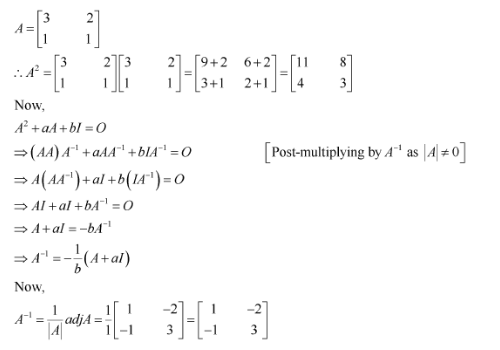

Hence, −4 and 1 are the required values of a and b respectively.
Question 15:
For the matrix 
Answer:
From equation (1), we have:
Question 16:
If 
Answer:
From equation (1), we have:
Question 17:
Let A be a nonsingular square matrix of order 3 × 3. Then is equal to
(A) (B)
(C)
(D)
Answer:
Answer: B
We know that
Hence, the correct answer is B.
Question 18:
If A is an invertible matrix of order 2, then det (A−1) is equal to A. det (A) B 
Answer:
Since A is an invertible matrix,
Hence, the correct answer is B.
NCERT Solutions For Class 12 Maths Chapter 4 Determinants Ex 4.6 Summary
Question 1:
Examine the consistency of the system of equations.
x + 2y = 2
2x + 3y = 3
Answer:
The given system of equations is:
x + 2y = 2
2x + 3y = 3
The given system of equations can be written in the form of AX = B, where
∴ A is non-singular.
Therefore, A−1 exists.
Hence, the given system of equations is consistent.
Question 2:
Examine the consistency of the system of equations.
2x − y = 5
x + y = 4
Answer:
The given system of equations is:
2x − y = 5
x + y = 4
The given system of equations can be written in the form of AX = B, where
∴ A is non-singular.
Therefore, A−1 exists.
Hence, the given system of equations is consistent.
Question 3:
Examine the consistency of the system of equations.
x + 3y = 5
2x + 6y = 8
Answer:
The given system of equations is:
x + 3y = 5
2x + 6y = 8
The given system of equations can be written in the form of AX = B, where
∴ A is a singular matrix.
Thus, the solution of the given system of equations does not exist. Hence, the system of equations is inconsistent.
Question 4:
Examine the consistency of the system of equations.
x + y + z = 1
2x + 3y + 2z = 2
ax + ay + 2az = 4
Answer:
The given system of equations is:
x + y + z = 1
2x + 3y + 2z = 2
ax + ay + 2az = 4
This system of equations can be written in the form AX = B, where
∴ A is non-singular.
Therefore, A−1 exists.
Hence, the given system of equations is consistent.
Question 5:
Examine the consistency of the system of equations.
3x − y − 2z = 2
2y − z = −1
3x − 5y = 3
Answer:
The given system of equations is:
3x − y − 2z = 2
2y − z = −1
3x − 5y = 3
This system of equations can be written in the form of AX = B, where
∴ A is a singular matrix.
Thus, the solution of the given system of equations does not exist. Hence, the system of equations is inconsistent.
Question 6:
Examine the consistency of the system of equations.
5x − y + 4z = 5
2x + 3y + 5z = 2
5x − 2y + 6z = −1
Answer:
The given system of equations is:
5x − y + 4z = 5
2x + 3y + 5z = 2
5x − 2y + 6z = −1
This system of equations can be written in the form of AX = B, where
∴ A is non-singular.
Therefore, A−1 exists.
Hence, the given system of equations is consistent.
Question 7:
Solve system of linear equations, using matrix method.
Answer:
The given system of equations can be written in the form of AX = B, where
Thus, A is non-singular. Therefore, its inverse exists.
Question 8:
Solve system of linear equations, using matrix method.
2x-y=-2
3x+4y=3
Answer:
The given system of equations can be written in the form of AX = B, where
Thus, A is non-singular. Therefore, its inverse exists.
Question 9:
Solve system of linear equations, using matrix method.
4x-3y=3
3x-5y=7
Answer:
The given system of equations can be written in the form of AX = B, where
Thus, A is non-singular. Therefore, its inverse exists.
Question 10:
Solve system of linear equations, using matrix method.
5x + 2y = 3
3x + 2y = 5
Answer:
The given system of equations can be written in the form of AX = B, where
Thus, A is non-singular. Therefore, its inverse exists.
Question 11:
Solve system of linear equations, using matrix method.
Answer:
The given system of equations can be written in the form of AX = B, where
Thus, A is non-singular. Therefore, its inverse exists.
Question 12:
Solve system of linear equations, using matrix method.
x − y + z = 4
2x + y − 3z = 0
x + y + z = 2
Answer:
The given system of equations can be written in the form of AX = B, where
Thus, A is non-singular. Therefore, its inverse exists.
Question 13:
Solve system of linear equations, using matrix method.
2x + 3y + 3z = 5
x − 2y + z = −4
3x − y − 2z = 3
Answer:
The given system of equations can be written in the form AX = B, where
Thus, A is non-singular. Therefore, its inverse exists.
Question 14:
Solve system of linear equations, using matrix method.
x − y + 2z = 7
3x + 4y − 5z = −5
2x − y + 3z = 12
Answer:
The given system of equations can be written in the form of AX = B, where
Thus, A is non-singular. Therefore, its inverse exists.
Question 15:
If 
Answer:
Now, the given system of equations can be written in the form of AX = B, where
Question 16:
The cost of 4 kg onion, 3 kg wheat and 2 kg rice is Rs 60. The cost of 2 kg onion, 4 kg
wheat and 6 kg rice is Rs 90. The cost of 6 kg onion 2 kg wheat and 3 kg rice is Rs 70.
Find cost of each item per kg by matrix method.
Answer:
Let the cost of onions, wheat, and rice per kg be Rs x, Rs y,and Rs z respectively.
Then, the given situation can be represented by a system of equations as
This system of equations can be written in the form of AX = B, where
Now,
X = A−1 B
Hence, the cost of onions is Rs 5 per kg, the cost of wheat is Rs 8 per kg, and the cost of rice is Rs 8 per kg.
NCERT Solutions For Class 12 Maths Chapter 4 Determinants Miscellaneous Solutions
Question 1:
Prove that the determinant 
Answer:
Δ=
Question 2:
Without expanding the determinant, prove that
Answer:
Hence, the given result is proved.
Question 3:
Evaluate
Answer:
Δ=
Expanding along C3, we have:
Question 4:
If a, b and c are real numbers, and
Show that either a + b + c = 0 or a = b = c.
Answer:
Expanding along R1, we have:
Hence, if Δ = 0, then either a + b + c = 0 or a = b = c.
Question 5:
Solve the equations
Answer:
Question 6:
Prove that
Answer:
Expanding along R3, we have:
Hence, the given result is proved.
Question 7:
If
Answer:
We know that
Question 8:
Let 
(i)
(ii)
Answer:
(i)
We have,
(ii)
Question 9:
Evaluate
Answer:
Δ=
Expanding along R1, we have:
Question 10:
Evaluate
Answer:
Expanding along C1, we have:
Δ=1(xy-0)=xy
Question 11:
Using properties of determinants, prove that:
Answer:
Expanding along R3, we have:
Hence, the given result is proved.
Question 12:
Using properties of determinants, prove that:
Answer:
Expanding along R3, we have:
Hence, the given result is proved.
Question 13:
Using properties of determinants, prove that:
Answer:
Expanding along C1, we have:
Hence, the given result is proved.
Question 14:
Using properties of determinants, prove that:
Answer:
Expanding along C1, we have:
Hence, the given result is proved.
Question 15:
Using properties of determinants, prove that:
Answer:
Hence, the given result is proved.
Question 16:
Solve the system of the following equations
Answer:
Let
Then the given system of equations is as follows:
This system can be written in the form of AX = B, where
Thus, A is non-singular. Therefore, its inverse exists.
Now,
A11 = 75, A12 = 110, A13 = 72
A21 = 150, A22 = −100, A23 = 0
A31 = 75, A32 = 30, A33 = − 24
Question 17:
Choose the correct answer.
If a, b, c, are in A.P., then the determinant
A. 0 B. 1 C. x D. 2x
Answer:
Answer: A
Here, all the elements of the first row (R1) are zero.
Hence, we have Δ = 0.
The correct answer is A.
Question 18:
Choose the correct answer.
If x, y, z are nonzero real numbers, then the inverse of matrix

(A) 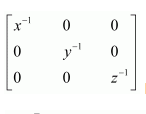
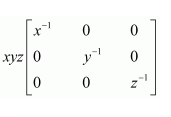

Answer:
Answer: A
The correct answer is A.
Question 19:
Choose the correct answer.
Let 
A. Det (A) = 0
B. Det (A) ∈ (2, ∞)
C. Det (A) ∈ (2, 4)
D. Det (A)∈ [2, 4]
Answer:
Answer: D
Now, 0≤θ≤2π
⇒-1≤sinθ≤1
The correct answer is D.

